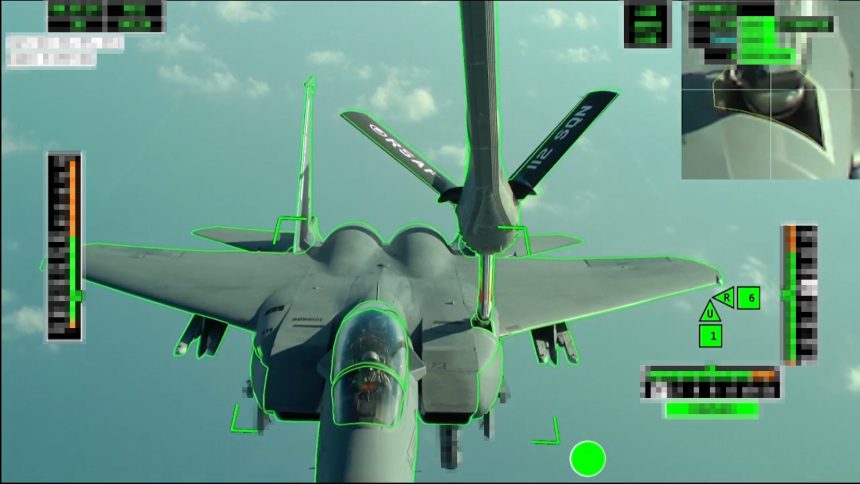The Republic of Singapore Air Force (RSAF) will become the first Air Force in the world to have a boom automatic refuelling capability with all of its receivers.
In 2020, an Airbus MRTT test aircraft carried out the world’s first ever fully automatic refuelling contacts during a flight test campaign over the Atlantic Ocean, that involved an Airbus 310 MRTT test aircraft equipped with the Airbus A3R solution (that equips the A330 MRTT) and a Portuguese Air Force F-16 jet acting as a receiver. In July 2022, the A330 MRTT became the world’s first tanker certified for automatic air-to-air refuelling operations in daylight conditions with F-16s and A330 MRTTs as receivers.
Today Airbus announced the successful completion of a testing campaign with the Airbus A330 Multi Role Tanker Transport (MRTT) and F-15 fighter of the Republic of Singapore Air Force (RSAF), ahead of its certification in the first half of 2024.
The testing campaign took place over the course of three weeks in August and included more than 500 automated wet and dry contacts with the air force’s full fleet of receiver aircraft, including the F-15SG aircraft, variant based on the standard F-15E, and embedding some enhancements: the APG-63(V)3 AESA radar, a Sniper XR EO/laser targeting pod and the AAS-43 Tiger Eyes IRST (infrared search-and-track system), the ALQ-135M system, an NVG-compatible cockpit, the JHMCS (Joint Helmet Mounted Cueing System) and the ability to drop a wide array of weapons, including the AIM-9X Sidewinder, the AIM-120C AMRAAM, the AGM-154 JSOW (Joint Stand Off Weapon), the SDB (Small Diameter Bomb).
“The A330 MRTT has made the future of air-to-air refuelling a reality as a result of the joint efforts of Airbus and the Republic of Air Force,” said Jean-Brice Dumont, Head of Military Air Systems at Airbus Defence and Space in a public release. “This new milestone will enable the RSAF to become the first Air Force in the world to have a boom automatic refuelling capability with all of its receivers, a capability that can be extended to refuelling receivers from other nations”.
The flight tests with F-15SG were conducted in Singapore, under the supervision of the Spanish certifying authority, called INTA (National Institute for Aerospace Technology), and covered the whole operational AAR envelope in different weather conditions. The test campaign also included night A3R and involved also RSAF F-16 receivers with the purpose of enabling night capabilities with the automated system.
As highlighted in a past story on this topic:
the use of an automatic refuelling system reduces the air-refuelling operator workload, especially in the aerial refueling operations that involve the use of a flying boom, a rigid, telescoping tube, maneuvered by a “boom operator” by means of a control stick. As opposed to the “hose and drogue” system this AAR system has the advantage to eliminate the requirement for the receiver pilot to plug the IFR (In Flight Refueling) probe into the hose’s drogue: once the aircraft has reached the refueling position the operator moves the boom to insert the tube in the receptacle of the receiver aircraft. The flying boom is the standard AAR system used by the U.S. Air Force and required by aircraft that are equipped with a receptacle (as the F-16, F-15 or the F-35).
Unlike the “hose and drogue” system with the flying boom, the effort of the AAR operation is mostly on the “boomer” (another nickname for the operator who moves the telescoping tube). In the previous generation tankers, as the U.S. KC-135 and KC-10, the boomer had to control the boom while lying prone inside a boom operator station located in the rear of the aircraft, watching the receiver through a rear observation window. More modern tankers, as the KC-767 and the problematic KC-46, use a remote boom operator’s station located behind the cockpit from where boomers move the boom using a joystick and watching the video from a series of cameras mounted on the tanker’s fuselage: the advanced camera system feeds a Remote Vision System (RVS) that provides high-definition stereoscopic imagery to the vision goggles attached to a sort-of flight helmet worn by the boomer during the air-to-air refueling.
The way the A3R system operates is particularly interesting, as it needs the ARO (Air Refueling Operator) to simply monitor the operation. In fact, once the system is activates, it’s the A3R system that flies the boom automatically and keeps the alignment between the boom tip and the receiver receptacle with an accuracy of a couple of centimeters. The proper alignment and the receiver stability is checked in real-time to keep a safe distance between the boom and the receiver and also to determine the optimum moment to extend the telescopic beam to achieve the connection with the receiver. After the “plug” the fuel transfer is initiated to fill up the receiver aircraft and once completed and the disconnection is commanded, the boom is cleared away from the receiver by retracting the telescopic beam and flying the boom away to keep a safe separation distance.









